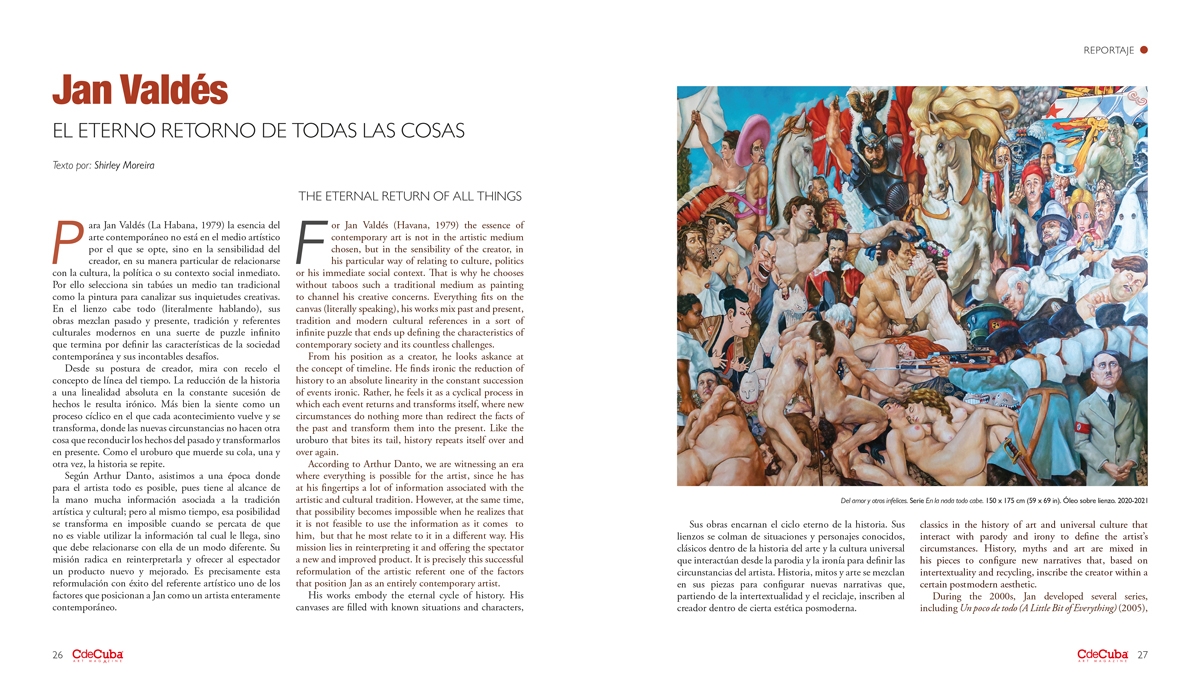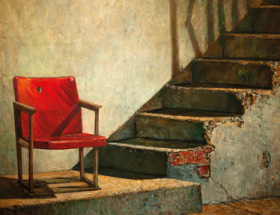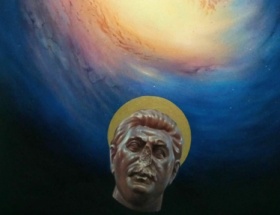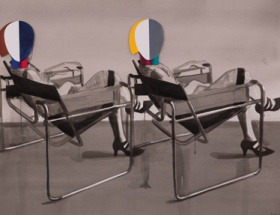The Eternal Return of All Things
By Shirley Moreira
For Jan Valdes (Havana, 1979) the essence of contemporary art is not in the artistic medium chosen, but in the sensibility of the creator, in his particular way of relating to culture, politics or his immediate social context. That is why he chooses without taboos such a traditional medium as painting to channel his creative concerns. Everything fits on the canvas (literally speaking), his works mix past and present, tradition and modern cultural references in a sort of infinite puzzle that ends up defining the characteristics of contemporary society and its countless challenges.
From his position as a creator, he looks askance at the concept of timeline. He finds ironic the reduction of history to an absolute linearity in the constant succession of events. Rather, he feels it as a cyclical process in which each event returns and transforms itself, where new circumstances do nothing more than redirect the facts of the past and transform them into the present. Like the uroburo that bites its tail, history repeats itself over and over again.
According to Arthur Danto, we are witnessing an era where everything is possible for the artist, since he has at his fingertips a lot of information associated with the artistic and cultural tradition. However, at the same time, that possibility becomes impossible when he realizes that it is not feasible to use the information as it comes to him, but that he most relate to it in a different way. His mission lies in reinterpreting it and offering the spectator a new and improved product. It is precisely this successful reformulation of the artistic referent one of the factors that position Jan as an entirely contemporary artist.
His works embody the eternal cycle of history. His canvases are filled with known situations and characters, classics in the history of art and universal culture that interact with parody and irony to define the artist’s circumstances. History, myths and art are mixed in his pieces to configure new narratives that, based on intertextuality and recycling, inscribe the creator within a certain postmodern aesthetic.
During the 2000s, Jan developed several series, including Un poco de todo (A little bit of everything) (2005), Lo extraordinario de lo ordinario (The extraordinary in the ordinary) (2008) and Por el lado más salvaje de la vida (On the wilder side of life) (2013), where the artist’s interest in appropriating artistic and cultural references from the past in order to generate a new critical discourse related to the present was already beginning to be noticed. On the other hand, the human component, the body in its exuberant nudity and imperfection as a palpable and realistic manifestation of life, also became the center of his analysis.
Towards the year 2020, the visual and discursive searches of the previous works find a meeting point in the series En la nada cabe todo (In nothingness there is room for everything). On this occasion, the human figure, its myths and conflicts are placed as the neuralgic axis of his concerns. The suffering of Tantalus in front of the pond, the overwhelming punishment of Sisyphus condemned to eternally push the rock uphill, Charon carrying away the souls… are some of the mythological themes to which the artist turns to assume them as metaphors of the dynamics of contemporary society. His pieces become that space where history and its cycles take place, where the narratives that allude to the constant obsessions of man over the years expand and coexist.
A certain horror vacui defines many of the visual constructions of this artist. His compositions are a reflection of life, and like life, they cannot be anything other than an immense collage of characters and situations. He returns to the iconography of Van Gogh, Sorolla, Goya, Picasso… great works of art history in dialogue also with other cultural references such as Che, Charles Chaplin, the Statue of Liberty or Pixar cartoons. In the pieces The Land of Pinocchio, The Divine Comedy Club or Of Love and Other Unhappy People, direct allusions to love, hate, religion, war, lies, sex… are intermingled in this pleiad of images that, in their forced dialogue, generate a great sensation of hilarity to define the ups and downs of contemporary society. Thus, Jan’s figurations constitute an accurate description of the contradictory essence of human nature.
Since the late 1980s, the Cuban art scene has shown interesting proposals that, moved by a postmodern spirit, have used intertextuality to offer a novel creative product. Starting from referents such as Consuelo Castañeda, Reinerio Tamayo or Eduardo Abela, the work of Jan Valdés rises from his individuality and adds to this wonderful way of assuming the creative gesture, where the most serious conflicts are treated with a certain dose of humor (very much in tune with the true essence of the Cuban). Jan’s pieces carry with them a gesture of tribute and at the same time a playful game with the symbolic arsenal of culture and universal history. They are spaces of time where everything fits, and where what is known is suddenly transformed into something entirely new.






